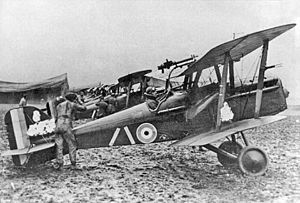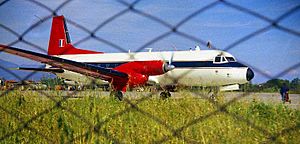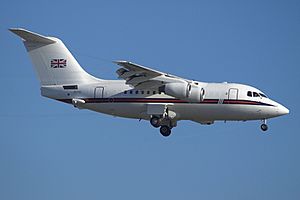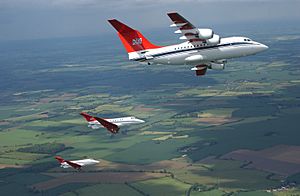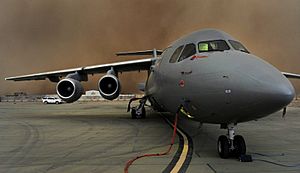No. 32 Squadron RAF facts for kids
Quick facts for kids No. 32 (The Royal) Squadron RAF |
|
|---|---|
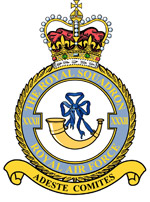
Squadron badge
|
|
| Active | 12 January 1916 – 1 April 1918 (RFC) 1 April 1918 – 29 December 1919 (RAF) 1 April 1923 – present |
| Country | |
| Branch | |
| Type | Flying squadron |
| Role | Command Support Air Transport |
| Size | Three aircraft |
| Part of | No. 2 Group |
| Home station | RAF Northolt |
| Motto(s) | Adeste Comites (Latin for 'Rally round, comrades') |
| Aircraft |
|
| Insignia | |
| Squadron badge heraldry | A hunting horn stringed, representing the unit's ability to hunt the enemy. Approved by King George VI in December 1936. |
| Post 1950 Squadron Roundel |  |
| Squadron Codes | KT (Oct 1938 – Sep 1939) GZ (Sep 1939 – Nov 1942, Jul 1944 – May 1949) |
Number 32 (The Royal) Squadron is a special part of the Royal Air Force (RAF). It flies important people, like government officials and even members of the Royal Family, around. This squadron is based at RAF Northolt in Greater London.
The squadron first started in 1916 as part of the Royal Flying Corps. It was a fighter squadron during both the First and Second World Wars. In 1969, it changed its role to focus on transporting important people. In 1995, it joined with the Queen's Flight, which was the special air service for the Royal Family. That's when it added "The Royal" to its name.
Today, the squadron's planes are mainly used for military operations. If they are not needed for military tasks, then they can be used to transport VIPs. The squadron currently uses Dassault Envoy IV CC1 jets and Leonardo AW109SP GrandNew helicopters.
Contents
History of No. 32 (The Royal) Squadron
How the Squadron Started: First World War Missions
No. 32 Squadron began on 12 January 1916 at Netheravon Airfield. It quickly moved to France as a fighter squadron, flying Airco DH.2 planes. On 1 July 1916, its leader, Major Lionel Rees, bravely fought eight German planes alone. Even though he was wounded, he managed to drive away the enemy aircraft. For this amazing act, he received the Victoria Cross, the highest military award.
The squadron continued to fly patrols over the Western Front. They flew over major battlefields like the Somme and Arras. Later, they started using Airco DH.5 planes for ground attacks. By December 1917, they switched to S.E.5a aircraft, which they used for the rest of the war. On 1 April 1918, the squadron became part of the new Royal Air Force. After the war, it returned to the UK and was disbanded on 29 December 1919. Many brave pilots, known as "aces," served with the squadron during the war.
Between the World Wars: New Aircraft
No. 32 Squadron was reformed on 1 April 1923 at RAF Kenley. It started with a single group of Sopwith Snipe fighter planes. Over the next year, it grew to full strength with more groups. The squadron regularly updated its aircraft. They flew Gloster Grebes, then Gloster Gamecocks, followed by Armstrong Whitworth Siskins, Bristol Bulldogs, and Gloster Gauntlets. In October 1938, just before the Second World War, they received the famous Hawker Hurricane fighter plane.
Second World War: Defending Britain
In May 1940, No. 32 Squadron flew patrols over northern France. They played a vital role in defending south-east England during the early weeks of the Battle of Britain. They were based at RAF Biggin Hill but often flew from RAF Hawkinge. At the end of August 1940, the squadron moved to northern England.
In 1941, their Hurricanes didn't see much action. However, they tried to protect Fairey Swordfish planes during a dangerous mission in February 1942. This mission was to stop German warships like the Scharnhorst and Gneisenau from passing through the English Channel. After this, they performed night missions before moving overseas.
In December 1942, the squadron went to Algeria in North Africa as part of Operation Torch. They switched to flying Supermarine Spitfires by July 1943. They also helped in the Greek Civil War from September 1944 to February 1945.
After the War: From Fighters to VIP Transport
After the Second World War, the squadron continued as a fighter unit. They flew Spitfires, de Havilland Vampires, and de Havilland Venoms from various bases. These included places like Palestine, Cyprus, Egypt, Persian Gulf, Malta, and Jordan. In January 1957, the squadron started flying English Electric Canberra B.15 bombers from Cyprus. It remained there until it was disbanded on 3 February 1969.
At the same time, another unit called the Metropolitan Communications Squadron was renamed No. 32 Squadron. This unit was already responsible for transporting important people. It used various aircraft, including Hawker Siddeley Andovers and Westland Whirlwind HC.10 helicopters.
In 1971, the squadron got four HS.125 CC.1 business jets. More HS.125s and BAe 125 CC3s were added later. From 1976, Aérospatiale Gazelle helicopters also served with the squadron. These were later replaced by Eurocopter Twin Squirrels in 1996.
In 1983, the RAF tested two BAe 146 planes. These planes were so good that two were bought for the Queen's Flight in 1984. A third BAe 146 was bought in 1989. These planes could fly much further and carry more passengers than the older Andover planes.
On 1 April 1995, the Queen's Flight joined No. 32 Squadron. This is when it became No. 32 (The Royal) Squadron. The squadron also moved to RAF Northolt. Since then, its aircraft have been used in many conflicts, like the Gulf War, Afghanistan, and Iraq. This merger meant that the RAF no longer had planes just for VIPs. Now, the squadron's planes are always ready for military missions first. If they are not needed for military tasks, then they can be used for royal or other non-military transport.
In 2004, the squadron's aircraft changed their look. They used to have a special red paint scheme, but this was changed to make the planes less noticeable. This was done for safety reasons.
In 2005, the squadron received three AgustaWestland AW109E helicopters to replace the Twin Squirrels. Two of these continued in use until 2012. You can see two of the squadron's old Wessex helicopters at The Helicopter Museum and Royal Air Force Museum London.
In 2012, two more BAe 146 planes were bought. These were changed to carry cargo and people for military use. They arrived in Afghanistan in April 2013. On 16 March 2015, the squadron's last BAe 125 planes were retired. They were removed from service earlier than planned due to budget cuts.
In late 2015, a new AgustaWestland AW109SP helicopter was delivered to the squadron. In 2017, the squadron received special awards called Battle Honours for its service in 'Iraq 2003–2011' and 'Libya 2011'.
In 2020, the squadron's two BAe 146 C3 planes were changed to help with medical support. They could carry patients and medical staff to and from smaller airfields. The four BAe 146 planes were retired in March 2022. They were replaced by two Dassault Falcon 900LX jets. Some of the retired BAe 146 planes are now in museums.
What's Next for the Squadron?
In August 2023, it was announced that the contract for the squadron's AgustaWestland AW109SP helicopter would not be renewed. This means the helicopter service will end on 30 September 2023.
Squadron Aircraft Today
The squadron has two main groups of aircraft:
- A' Flight
- Two Dassault Envoy IV CC1 jets
- B' Flight
- One AgustaWestland AW109SP helicopter
Battle Honours: Recognising Bravery
Battle honours are special awards given to military units for their bravery and service in battles. No. 32 Squadron has received many battle honours throughout its history. Those marked with an asterisk (*) can be proudly displayed on the squadron's flag.
- Western Front (1916–1918)
- Somme (1916–1918)
- Arras (1917)
- Ypres (1917)
- Amiens (1918)*
- France and Low Countries (1939–1940)*
- Battle of Britain (1940)*
- Home Defence (1940–1945)
- Dieppe (1942)
- North Africa (1942-1943)*
- Italy (1943)
- South East Europe (1944-1945)*
- Gulf (1991)
- Iraq (2003–2011)
- Libya (2011)
See also
- Spirit of the Few Monument – sculptures of seven of the squadron's Second World War pilots
- Air transport of the British royal family and government
- Air transports of heads of state and government


